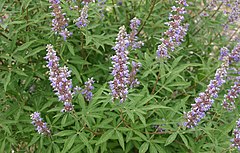Vitex agnus-castus
| Vitex agnus-castus subsp. var. | Vitex, Chaste Tree, Chasteberry, Hemp Tree, Monk's Pepper | |||||||||||||||||||||||||||||||||||||||||||||||||||||||
|---|---|---|---|---|---|---|---|---|---|---|---|---|---|---|---|---|---|---|---|---|---|---|---|---|---|---|---|---|---|---|---|---|---|---|---|---|---|---|---|---|---|---|---|---|---|---|---|---|---|---|---|---|---|---|---|---|

|
|
| ||||||||||||||||||||||||||||||||||||||||||||||||||||||
| ||||||||||||||||||||||||||||||||||||||||||||||||||||||||
| Standard Cyclopedia of Horticulture |
|---|
|
Vitex agnus-castus, Linn. Chaste-Tree. Hemp-tree. Monk's Pepper-Tree. Shrub or small tree, with a strong aromatic odor, grayish tomentose: lvs. long-stalked; lfts. 5-7, lanceolate, acuminate, narrowed at the base into a short stalk, entire or with few coarse teeth, grayish-tomentose beneath, the middle one 3-4 in. long: the fls. in dense, sessile clusters, forming terminal, often panicled spikes 5-7 in. long; corolla usually pale or lilac, grayish outside, 1/3 in. long; stamens and style exserted. July-Sept. S. Eu., W. Asia. Var. alba, Rehd. (V. albiflora, Hort. Agnus-castus vulgaris alba, Carr.). Fls. white.
|
Cultivation
Grow in almost any type of soil, and prefer dry situationsCH.
Grows best in light loamy soil with good drainage, in a warm sunny sheltered position. Does well in dry soils, does not tolerate soil that remains wet. Hardy to approx. -10°C. Plants only flower freely in a warm summer, so in cooler climates should be grown against a south facing wall. Leaves and stems highly aromatic, with deliciously scented flowers and the dried seeds giving off a strong lemony scent. Flowers produced at ends of the current year's growth, very late in the season. Therefore pruning is best done in the spring.
Propagation
Seeds in spring, greenwood cuttings under glass, layeringCH.
Sow the easy-to-germinate seeds indoors in March. In cooler climate, keep in pots in a greenhouse the first year and winter to give them greater success upon outdoor planting the following summer. Take cuttings in mid-late summer which are 5-8cm of semi-ripe wood, with a heel, or mature wood can be taken in November to be placed in a cold frame.
Pests and diseases
- Do you have pest and disease info on this plant? Edit this section!
Cultivars
Gallery
If you have a photo of this plant, please upload it! Plus, there may be other photos available for you to add.
References
- Standard Cyclopedia of Horticulture, by L. H. Bailey, MacMillan Co., 1963
External links
- w:Vitex agnus-castus. Some of the material on this page may be from Wikipedia, under the Creative Commons license.
- Vitex agnus-castus QR Code (Size 50, 100, 200, 500)










